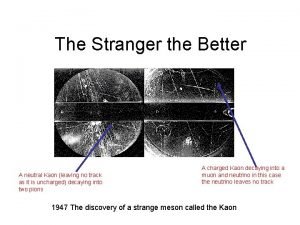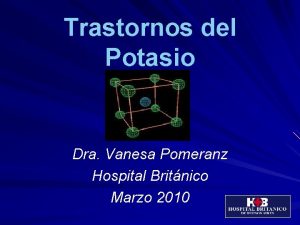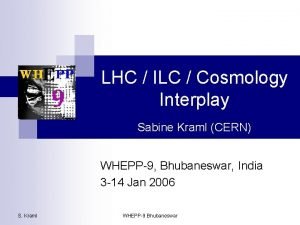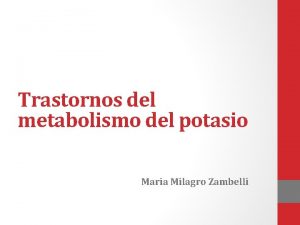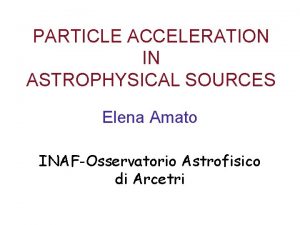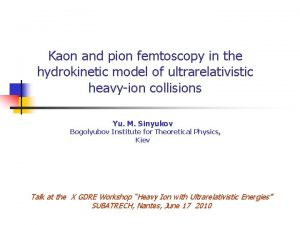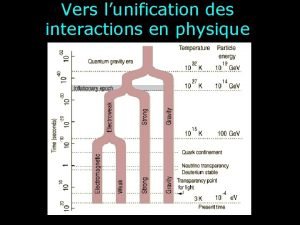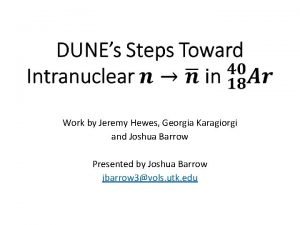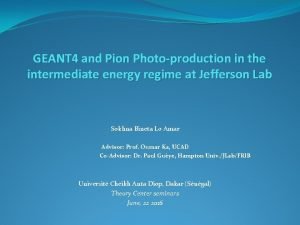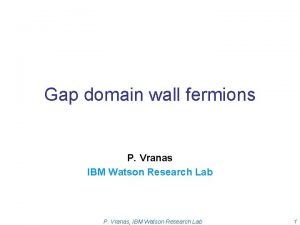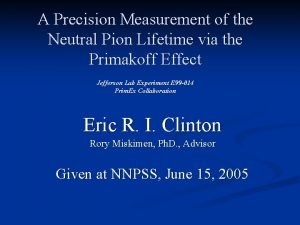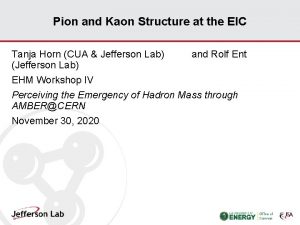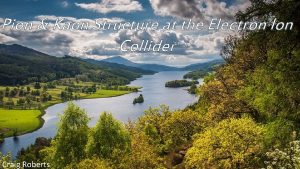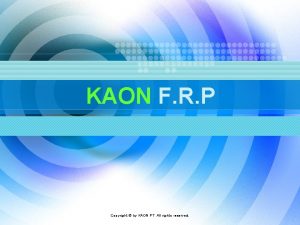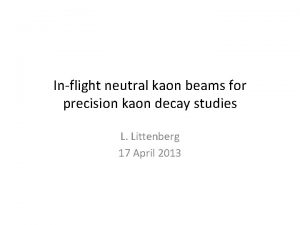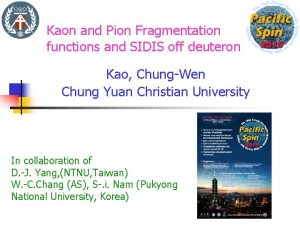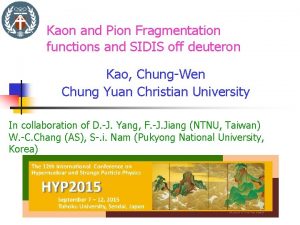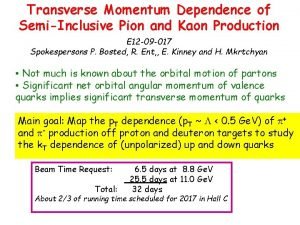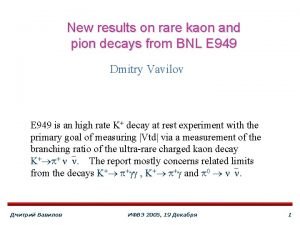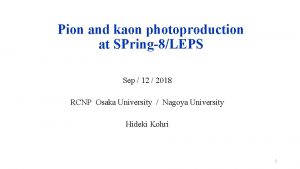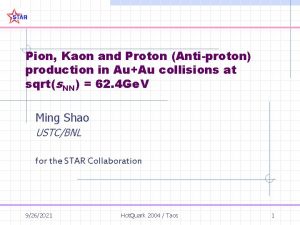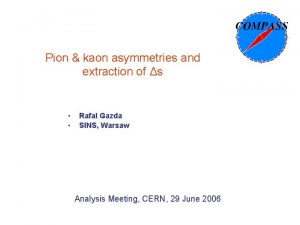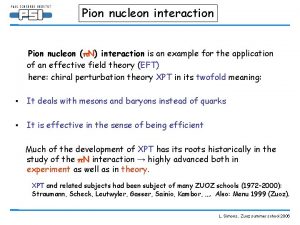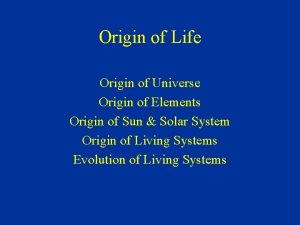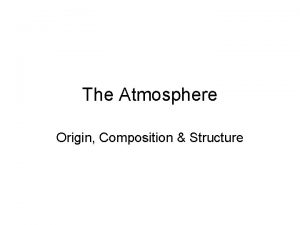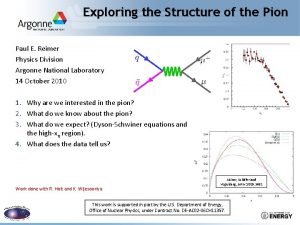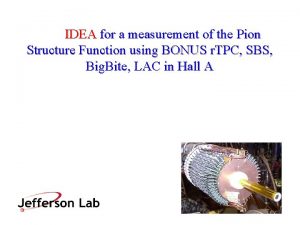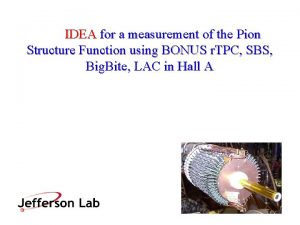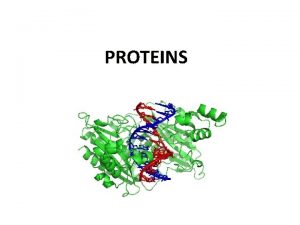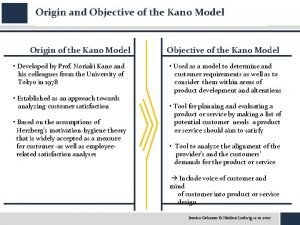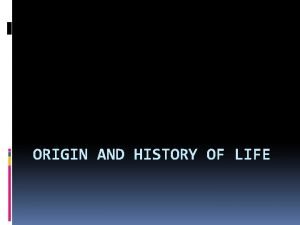Pion and Kaon Structure and the Origin of

































- Slides: 33

Pion and Kaon Structure and the Origin of Mass Rolf Ent (Jefferson Lab) 3 rd Proton Mass Workshop; Origin and Perspective Argonne National Lab January 14 -16, 2021

Pion and Kaon Structure and the Origin of Mass “presentation of the JLab/EIC proposed measurements as it relates to the origin of mesons masses. ” Context: much work related to this by large group of theorists and experimentalists in context of EIC-related workshops (“Pion and Kaon Structure at the EIC”), an EIC white paper, and a sub-group on meson structure as part of the EICUG Yellow Report initiative. 2

Pion and Kaon Structure at the EIC – History q PIEIC Workshops hosted at ANL (2017) and CUA (2018) q ECT* Workshop: Emergent Mass and its Consequences (2018) PIEIC White Paper (2019) IC E n t a 190 a re 0, u 1 t uc 9) r 1 t n S 5 (20 o a 5 K A d. an s. J n Pio. Phy r Eu q q AMBER/CERN Workshop (2020) CFNS Workshop (2020) EHM through AMBER@CERN (2020) ECT* Workshop in 2021 (remote) & 2022 3

Meson Structure Functions Yellow Report Working Group Formed in 2019 in context of the EIC User Group Yellow Report Effort Ø Meson SF WG: 22 members, 13 institutions, 7 countries Ø Blue. Jeans meetings every 2 -3 weeks since January 2020 Ø To join the Meson Structure Functions WG mailing list, contact T. Horn (hornt@cua. edu) Meson SF Working group members: John R. Arrington (LBNL), Carlos Ayerbe Gayoso (Mississippi State U), Daniele Binosi (ECT*), Lei Chang (Nankai U. ), Rolf Ent (Jlab), Tobias Frederico (Instituto Tecnologico de Aeronautica), Timothy Hobbs (SMU), Tanja Horn (CUA), Garth Huber (U. Regina), Stephen Kay (U. Regina), Cynthia Keppel (Jlab), Bill Lee (W&M) ), Huey-Wen Lin (MSU), Rachel Montgomery (U. Glasgow), Ian L. Pegg (CUA), Paul Reimer (ANL), David Richards (Jlab), Craig Roberts (Nanjng U. ), Jorge Segovia (Universidad Pablo de Olavide), Arun Tadepalli (JLab), Richard Trotta (CUA), Rik Yoshida (ANL) Ø Within Yellow Report activities, part of the EIC Diffractive Reactions & Tagging PWG Ø Very successful effort, and lively discussions, so Meson SF WG is likely to continue existing. 4

Mass of the Proton, Pion, Kaon Visible world: mainly made of light quarks – its mass emerges from quark-gluon interactions. “Mass without mass!” Me. V Proton Quark structure: uud Mass ~ 940 Me. V (~1 Ge. V) Most of mass generated by dynamics. Gluon rise discovered by HERA e-p Ge. V Pion Kaon Quark structure: ud Mass ~ 140 Me. V Exists only if mass is dynamically generated. Empty or full of gluons? Quark structure: us Mass ~ 490 Me. V Boundary between emergentand Higgs-mass mechanisms. More or less gluons than in pion? For the proton the EIC will allow determination of an important term contributing to the proton mass, the so-called “QCD trace anomaly” For the pion and the kaon the EIC will allow determination of the quark and gluon contributions to mass with the Sullivan process. 5

Origin of Mass in the EIC Yellow Report, exec. summary, pages 9/10 6

The Role of Gluons in the Chiral Limit 7

Mass Budgets for the Proton, Kaon and Pion 8

Strong Synergy with Lattice QCD Huey-Wen Lin et al. Parton distribution amplitudes Pion at two different pion masses & extrapolated to the physical mass Fit to lattice data for kaon, and using machine learning approach As the pion mass decreases, the distribution amplitude gets broader Note the slight asymmetry in the distribution amplitude around x = 0. 5 Calculations using meson-boosted momentum at Pz = 1, . 73 Ge. V and renormalized at 2 Ge. V in MS-bar scheme 9

Emergent- versus Higgs-Mass Generation Twist-2 PDA at Scale z = 2 Ge. V A solid (green) curve – pion ⇐ emergent mass is dominant; B dot-dashed (blue) curve – ηc ⇐ primarily, Higgs mass generation; C solid (thin, purple) curve – conformal limit result, 6 x(1 - x); and Unfortunately, experimental signatures of the exact PDA form are, in general, difficult. D dashed (black) curve – “heavy-pion”, i. e. , a pion-like pseudo-scalar meson (~hs) in which the valence-quark current masses take values corresponding to a strange quark ⇐ the border, where emergent and Higgs mass generation are equally important. • In the limit of infinitely-heavy quark masses, the Higgs mechanism overwhelms every other mass generating force, and the PDA becomes a d-function at x = ½. • The sufficiently heavy hc meson (B), feels the Higgs mechanism strongly. • The PDA for the light-quark pion (A) is a broad, concave function, a feature of emergent mass generation. 10

Pion Form Factor and Emergent Mass Muyang Chen, Craig Roberts Left panel. Two dressed-quark mass functions distinguished by the amount of DCSB: emergent mass generation is 20% stronger in the system characterized by the solid green curve, which describes the more realistic case. Right panel. Fπ(Q 2) obtained with the mass function in the left panel: rπ = 0. 66 fm with the solid green curve and rπ = 0. 73 fm with the dashed blue curve. The long-dashed green and dot-dashed blue curves are predictions from the QCD hard-scattering formula, obtained with the related, computed pion PDAs. The dotted purple curve is the result obtained from that formula if the conformal-limit PDA is used, ϕ(x)=6 x(1 -x). 11

Pion Form Factor Prospects @ EIC 1. Models show a strong dominance of s. L at small –t at large Q 2. 2. Assume dominance of this longitudinal cross section 3. Measure the p-/p+ ratio to verify – it will be diluted (smaller than unity) if s. T is not small, or if non-pole backgrounds are large A. C. Aguilar et al. , EPJ A 55 (2019) 10, 190 q Assumed 5 Ge. V(e-) x 100 Ge. V(p) with an integrated luminosity of 20 fb-1/year, and similar luminosities for d beam data q R=s. L/s. T assumed from VR model – and assume that p pole dominance at small t confirmed in 2 H p-/p+ ratios q Assumed a 10% experimental systematic uncertainty, and a 100% systematic uncertainty in the model subtraction to isolate s. L Can we measure the kaon form factor at EIC? Or only through L/T separations emphasizing lower energies? Not clear – needs guidance from JLab 12 - Ge. V. 12

Pion and Kaon Structure - 12 Ge. V Jefferson Lab will provide, at its CM energy of 5 Ge. V, tantalizing data for the pion (kaon) form factor up to Q 2 ~ 10 (5) Ge. V 2, and measurements of the pion (kaon) structure functions at large-x (> 0. 5) through the Sullivan process. Pion FF – first quantitative access to hard scattering scaling regime? Pion SF – (1 -x)1 or (1 -x)2 dependence at large x? and kaon 13 JLab/12 Ge. V projection

Physics Objects for Pion/Kaon Structure Studies Sullivan process – scattering from nucleon-meson fluctuations Detect scattered electron DIS event – reconstruct x, Q 2, W 2, also MX (Wp) of undetected recoiling hadronic system Pion/Kaon target (undetected) Detect “tagged” neutron/lambda i = p, r, … “Flux factor” 14

EIC Meson Structure Kinematics Electron x Proton beam energies 5 Ge. V x 41 Ge. V 10 Ge. V x 135 Ge. V Leading neutron (or lambda) are at small forward angles and carry most of the proton beam momentum Scattered electron goes in EIC central detector region 15

Meson Structure: Summary of EIC Detector Requirements q For p-n: Ø Lower energies (5 on 41, 5 on 100) require at least 60 x 60 cm 2 Ø For all energies, the neutron detection efficiency is 100% with the planned ZDC q For p-n and K+/L: Ø All energies need good ZDC angular resolution for the required -t resolution Ø High energies (10 on 100, 10 on 135, 18 on 275) require resolution of 1 cm or better q K+/L benefits from low energies (5 on 41, 5 on 100) and also need: �� Ø �� →�� +�� : additional high-res/granularity EMCal+tracking before ZDC – seems doable q Standard electron detection requirements q Good hadron calorimetry for good x resolution at large x 16

EIC – Versatility and Luminosity is Key Why would pion and kaon structure functions, and even measurements of pion structure beyond (pion GPDs and TMDs) be feasible at an EIC? • LEIC = 1034 = 1000 x LHERA • Detection fraction @ EIC in general much higher than at HERA • Fraction of proton wave function related to pion Sullivan process is roughly 10 -3 for a small –t bin (0. 02). • Hence, pion data @ EIC should be comparable or better than the proton data @ HERA, or the 3 D nucleon structure data @ COMPASS • If we can convince ourselves we can map pion (kaon) structure for –t < 0. 6 (0. 9) Ge. V 2, we gain at least a decade as compared to HERA/COMPASS. 17 Ratio of the F 2 structure function related to the pion Sullivan process as compared to the proton F 2 structure function in the low-t vicinity of the pion pole, as a function of Bjorken-x (Jefferson Lab TDIS Collaboration, JLab Experiment C 12 -15 -005)

Pion Structure Function Projections vs x Integrated over –t from –tmin to 1 18

Pion Structure Function Projections vs -t -t-dependence can verify robustness of data interpretation 19

Reduction of Pion 1 -D Structure Information by EIC From ongoing EIC Yellow Report, P. Barry, W. Melnitchouk, N. Sato et al. 20

EIC – Meson Structure Questions 21

EIC – Meson Structure Questions Can we even do SIDIS or DES off meson target? 22

Summary – Pion and Kaon Structure • Protons, neutrons, pions and kaons are the main building blocks of nuclear matter If we really want to claim we understand hadron structure as relevant for the visible world, we HAVE to understand at least the pion, kaon, proton, neutron (and likely the Lambda) at the same level. • Paradoxically, the lightest pseudoscalar mesons appear to be the key to the further understanding of the emergent mass and structure mechanisms. • These mesons, namely the pion and kaon, are the Nambu-Goldstone boson modes of QCD. • Unraveling their exact partonic structure and interplay with the Higgs mass mechanism is a common goal of three independent methodologies – phenomenology with continuum QCD based approaches, Lattice QCD, and the global analysis of parton distributions – linked to experimental measurements of hadronic structure. 23

Summary – Role of EIC The unique role of EIC is its access to pion and kaon structure over a versatile large CM energy range, ~20 -140 Ge. V. With its larger CM energy range, the EIC will have the final word on the contributions of gluons in pions and kaons as compared to protons, settle how many gluons persist as viewed with highest resolution, and vastly extend the x and Q 2 range of pion and kaon charts, and meson structure knowledge. 24

25

Mass of the Visible Universe Gluon mass-squared function Visible world: mainly made of light quarks – its mass emerges from quark-gluon interactions. Higgs mechanism hardly plays a role The strange quark is at the boundary - both emergent-mass and Higgs-mass generation mechanisms are important. 26 Emergent mass of the visible universe

Experimental Validation (Pion Form Factor example) Experimental studies over the last decade have given confidence in the electroproduction method yielding the physical pion form factor Experimental studies include: Fp q Take data covering a range in –t and compare with theoretical expectation o Fp values do not depend on -t – confidence in applicability of model to the kinematic regime of the data -t [Ge. V 2] q Verify that the pion pole diagram is the dominant contribution in the reaction mechanism o RL (= s. L(p-)/s. L(p+)) approaches the pion charge ratio, consistent with pion pole dominance -t [Ge. V 2] [G. Huber et al, PRL 112 (2014)182501] 27 [T. Horn, C. D. Roberts, J. Phys. G 43 (2016) no. 7, 073001]

Kaon structure functions – gluon pdfs A. C. Aguilar et al. , EPJ A 55 (2019) 10, 190 Based on Lattice QCD calculations and DSE calculations: EIC Projections Ø Valence quarks carry 52% of the pion’s momentum at the light front, at the scale used for Lattice QCD calculations, or ~65% at the perturbative hadronic scale 10% 0% 1 st DSE analysis (Tandy et al. , fully numerical DSE solutions) gluon content of the kaon Ø At the same scale, valence-quarks carry ⅔ of the kaon’s light-front momentum, or roughly 95% at the perturbative hadronic scale Thus, at a given scale, there is far less glue in the kaon than in the pion: qheavier quarks radiate less readily than lighter quarks qheavier quarks radiate softer gluons than do lighter quarks q. Landau-Pomeranchuk effect: softer gluons have longer wavelength and multiple scatterings are suppressed by interference. q. Momentum conservation communicates these effects to the kaon's u-quark. 28

Intermezzo - Summary • Protons, neutrons, pions and kaons are the main building blocks of nuclear matter If we really want to claim we understand hadron structure as relevant for the visible world, we HAVE to understand at least the pion, kaon, proton, neutron (and likely the Lambda) at the same level. • The broad science program to understand pion and kaon structure and the QCD mechanism behind the emergent hadron masses requires a strong interplay between experiment and theory, matching experimental prospects by new theoretical insights, rapid computational advances, and high-level phenomenology • The EIC with its versatile large CM energy range will play a key role in the experimental program to chart in-pion and in-kaon distributions of interalia, mass, charge, magnetization and angular momentum, but. . . • … to provide experimental measurements guiding theoretical understanding requires a coherent, worldwide effort. 29

12 Ge. V/Eic. C/AMBER/EIC Complementarity COMPASS++/AMBER will play a crucial role as they can uniquely provide pion (kaon) Drell-Yan measurements in the CM energy region ~10 -20 Ge. V. Some older pion and kaon Drell-Yan measurements exist, but for the kaon this is limited to less than 10 data points worldwide, so these measurements are absolutely important for a global effort of the pion structure function measurements (allowing a handle on determination of the so-called “pion flux" for the EIC Sullivan process measurements) and a sinequanon for any kaon structure function data map. The COMPASS++/AMBER data in themselves will already give new fundamental insights in the emergent-hadron mass mechanism. Pionic Drell-Yan, 2 years: pionic sea! 30 Kaonic Drell-Yan, 140 days: much-needed precise data!

12 Ge. V/Eic. C/AMBER/EIC Complementarity An Electron-Ion Collider in China (Eic. C) is under consideration with a similar CM energy range as COMPASS++/AMBER of 10 -20 Ge. V and bridging the energy range from Jefferson Lab to EIC. Eic. C on its own, and even more in combination with COMPASS++/AMBER, can provide good access to the region of x > 0. 01 for pion, and especially kaon, structure function determination and the impact on emergent-hadron mass mechanisms on valence quark and gluon structure. In addition, Eic. C can extend the Rosenbluth L/T-separated cross section technique beyond Jefferson Lab and access pion and kaon form factors to higher Q 2 values, roughly by a factor of 2 -4. Pion structure function measurement projections at Q 2 ~ 4 Ge. V 2. Likely similar kaon structure function data possible at high xp. (ar. Xiv: 2008. 00102) 31

EIC Meson Structure Kinematics Scattered electron goes in EIC central detector region Leading neutron (or lambda) are at small forward angles and carry most of the proton beam momentum 32

EIC Far-Forward Detector Highly Integrated detector system: ~75 m 1. Central detector: ~10 m 2. Backward electron detection: ~35 m 3. Forward hadron spectrometer: ~40 m far-backward detectors Lesson learned from HERA – ensure low-Q 2 coverage Various stage detector to capture forward-going protons and neutrons, and also decay products (D, L). far-forward detectors 33
 Kaon
Kaon Manejo hipopotasemia
Manejo hipopotasemia Kaon cp violation
Kaon cp violation Hiperkalemia
Hiperkalemia Elena amato
Elena amato Pion
Pion Louis pion montre
Louis pion montre Georgia karagiorgi
Georgia karagiorgi Pion geant
Pion geant Gdwf
Gdwf Pion lifetime
Pion lifetime Hình ảnh bộ gõ cơ thể búng tay
Hình ảnh bộ gõ cơ thể búng tay Frameset trong html5
Frameset trong html5 Bổ thể
Bổ thể Tỉ lệ cơ thể trẻ em
Tỉ lệ cơ thể trẻ em Gấu đi như thế nào
Gấu đi như thế nào Tư thế worm breton là gì
Tư thế worm breton là gì Chúa yêu trần thế
Chúa yêu trần thế Kể tên các môn thể thao
Kể tên các môn thể thao Thế nào là hệ số cao nhất
Thế nào là hệ số cao nhất Các châu lục và đại dương trên thế giới
Các châu lục và đại dương trên thế giới Công thức tính độ biến thiên đông lượng
Công thức tính độ biến thiên đông lượng Trời xanh đây là của chúng ta thể thơ
Trời xanh đây là của chúng ta thể thơ Mật thư anh em như thể tay chân
Mật thư anh em như thể tay chân 101012 bằng
101012 bằng Phản ứng thế ankan
Phản ứng thế ankan Các châu lục và đại dương trên thế giới
Các châu lục và đại dương trên thế giới Thể thơ truyền thống
Thể thơ truyền thống Quá trình desamine hóa có thể tạo ra
Quá trình desamine hóa có thể tạo ra Một số thể thơ truyền thống
Một số thể thơ truyền thống Cái miệng nó xinh thế
Cái miệng nó xinh thế Vẽ hình chiếu vuông góc của vật thể sau
Vẽ hình chiếu vuông góc của vật thể sau Nguyên nhân của sự mỏi cơ sinh 8
Nguyên nhân của sự mỏi cơ sinh 8 đặc điểm cơ thể của người tối cổ
đặc điểm cơ thể của người tối cổ
